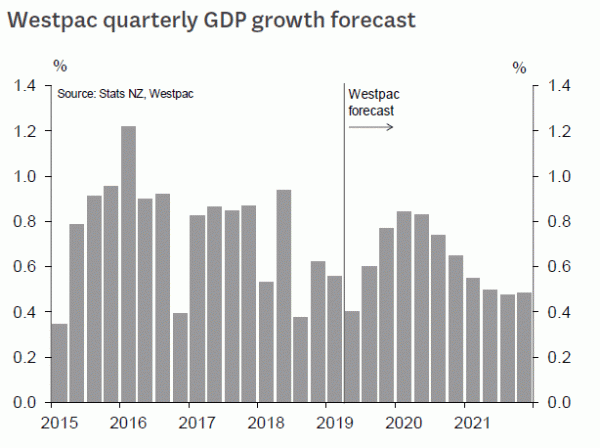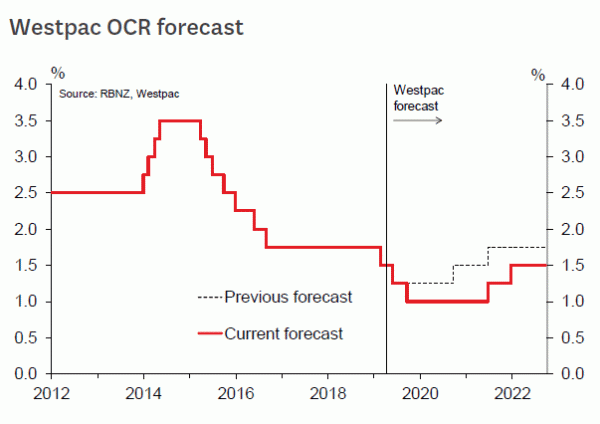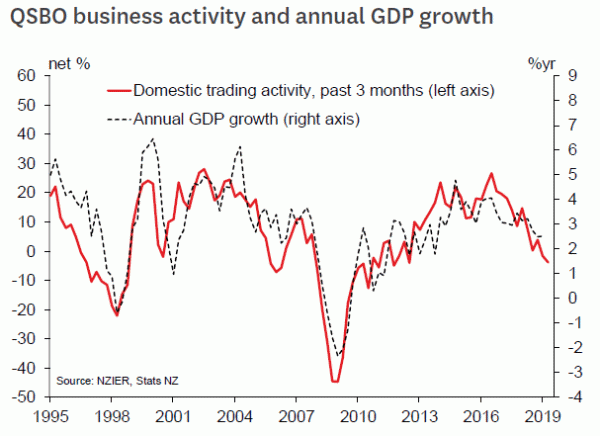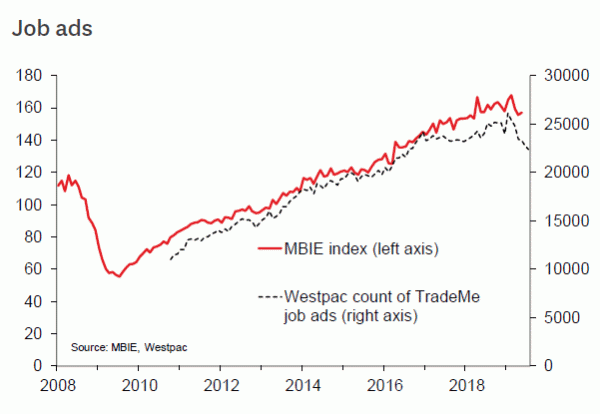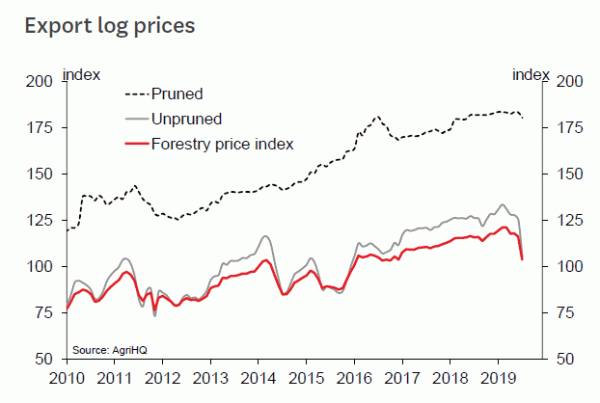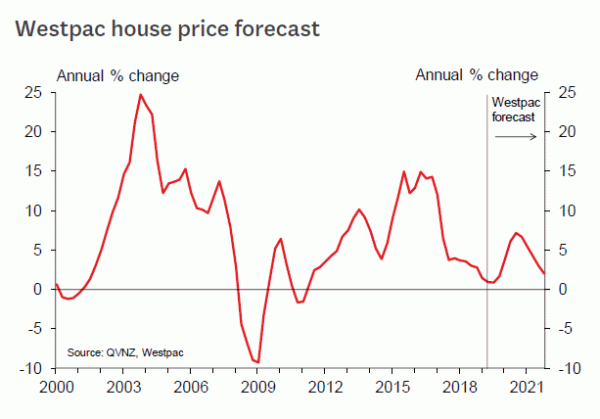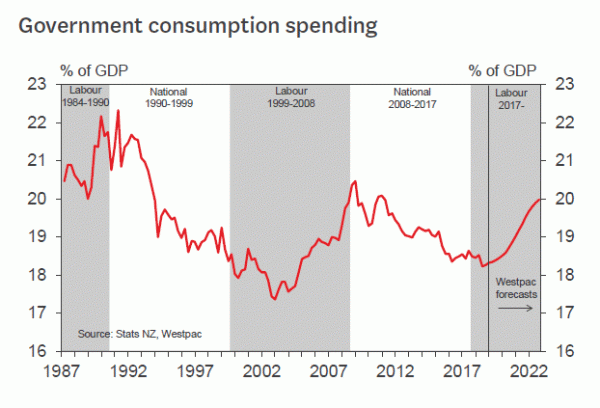- We previously forecast that the RBNZ would cut the OCR in August, citing global concerns.
- We now expect that the RBNZ will cut the OCR in both August and November.
- There is some risk the RBNZ could deliver the cuts more rapidly, in August and September, depending on how weak the labour market gets.
- The domestic economy has clearly slowed further than anticipated.
- Low business confidence is translating into slower hiring, and the forestry downturn could cause job losses.
- The recent rise in the exchange rate will also bother the RBNZ.
- If we are correct, retail fixed interest rates are going to fall even further.
- Lower mortgage rates will strengthen our call for a housing market upturn over the year ahead.
On 21 June we forecast that the Reserve Bank would cut the OCR to 1.25% at the August Monetary Policy Statement. Our focus at the time was on the slowing global economy and the increasing likelihood of the United States’ Federal Reserve cutting interest rates.
Today we are going further, and this time the reasons are domestic rather than global.
We now expect that the Reserve Bank will cut the OCR in August and again in November, taking the OCR to an all-time low of 1%. And the risk to our new call is skewed towards earlier and/or more aggressive cuts – there is a possibility that the RBNZ could cut the OCR in September, and even a possibility that the OCR could drop below 1%.
A slowdown in the New Zealand economy has been in train for almost two years now, and was well forecast by us. The wind down of the Canterbury rebuild and slowing house price growth were predictable, and caused the slowdown in GDP growth that we anticipated. But we previously expected that the economy would be picking up by mid- 2019, on the back of fiscal stimulus and lower interest rates. Instead, recent data suggests that New Zealand economic growth has remained slow.
The June Quarterly Survey of Business Opinion, published in early July, showed that business confidence had fallen to a ten-year low, despite the recent cancellation of capital gains tax. Businesses reported activity levels consistent with slow economic growth, and fewer firms said they were hiring. Firms remain caught between rising costs – often government-imposed, such as the minimum wage hike – and an inability to pass through price increases for their products. This is squeezing profits. Expected profitability in the survey dropped to its lowest since the GFC.
In addition to survey data, we are now seeing harder evidence that low business confidence is affecting the labour market. The official government series of job ads flatlined from November last year, and has actually fallen in the past couple of months. Our own count of job ads listed on TradeMe has fallen far more sharply. This is tentative data, so we are not ready to hang our hats on it just yet, but it suggests that unemployment could rise over the quarters ahead.
Electronic card transaction data has shown that consumer spending was basically flat in the June quarter. This matches the anecdotes we are hearing from businesses, as well as other second- and third-tier data, suggesting that domestic economic conditions remain slow despite the large doses of fiscal and monetary stimulus that have been administered recently. We still expect government spending and low interest rates to generate a pickup in GDP growth, but it has not come through yet (more on that later).
The tone of recent data prompted us to downgrade our GDP forecasts in early July. We now expect quarterly GDP growth to remain in the 0.4% to 0.6% range over the June and September quarters. We expect construction to continue growing at its current extremely strong pace, but other areas of the economy will be more subdued. Our forecast is for annual GDP growth to fall to 2%, which is only a sliver higher than the rate of population growth.
In addition to weak domestic economic growth, we are now seeing the first cracks emerge in the previously-robust export sector. Some sectors are still booming, but dairy auction prices fell 8% over May and June, prompting us to lower our farmgate milk price forecast to $6.90/kg (previously $7.20). And over the past month, there has been a 25% drop in export log prices. Forestry accounts for only 9% of our merchandise exports, but it is disproportionately important for the economic cycle due to its impact on employment. When log prices drop, forest owners often stop harvesting, with an immediate impact on employment and on the health of forestry contracting businesses. After the last log price downturn, in 2014, employment in the industry fell by 700 jobs. Other workers went onto reduced hours (and presumably reduced incomes). And of course, work for businesses involved in transporting forestry products and other related industries dried up, with an unknown impact on employment. This time could be similar.
To cap it all off, the trade-weighted exchange rate has risen about 3% over the past month, and is now about 1.5% higher than the forecast that underpinned the RBNZ’s May OCR decision. A higher exchange rate, if sustained, will compound the emerging concerns for some exporters and will suppress inflation by making imported products cheaper.
How the Reserve Bank will respond
The Reserve Bank will be well aware of these recent developments. Importantly, recent experience is that the new Reserve Bank Monetary Policy Committee has been activist and responsive to signs of slowing growth. We think they will respond to these latest signs of weakness by cutting the OCR in August, and stating that they might cut the OCR further, depending on the data. We expect that the RBNZ’s published forecasts will show the OCR dropping to 1.1%, implying a good chance (but not a certainty) of another cut. Such commentary would be more dovish than the May MPS, which shied away from providing forward guidance on the OCR.
Most likely, the RBNZ will reduce the OCR again in November, when the Monetary Policy Committee has the benefit of the full quarterly analysis undertaken by Bank staff. However, there is a chance that they could act even sooner, at the September OCR Review. One possible catalyst to an earlier OCR cut could be adverse news on the labour market. If the RBNZ does cut in September due to rising unemployment, then there is a chance that they could go even further by cutting the OCR to 0.75% in November. However, at this stage we view earlier or more aggressive OCR cuts as a risk scenario – our central forecast is an OCR low of 1% delivered in November.
How the economy will respond
We have been pointing out for some time that lowering interest rates will have consequences for asset markets, particularly house prices. In May we predicted that nationwide annual house price inflation would accelerate from 2% now to 7% over the year ahead, partly due to the mortgage rate declines already seen.
Recent data supports our view. Over the past two months, we estimate that seasonally adjusted housing market turnover has risen 10%. Brisker house sales are a reliable sign of price rises to come. Meanwhile, New Zealand appears to be in the grip of a “search for yield” investment environment more generally. Growth in bank deposits has been weak, as people have been turned off by low interest rates. Meanwhile, share market prices have risen very sharply, particularly for dividend-paying stocks, and we have heard anecdotes that fund managers are seeing an influx of investment funds. We think investors seeking yield will soon turn to the slower-moving housing market.
We will reassess our house price forecasts we when release our next Economic Overview in August. However, if we are right about the Reserve Bank cutting the OCR to 1% this year, then we can expect even lower fixed mortgage rates. That could prompt us to upgrade our house price forecast.
Rising house prices will tend to stimulate more consumer spending. On top of that, we are still expecting the large doses of government spending that have been administered over the past two Budgets to stimulate the economy. True, there has been little impact from the fiscal stimulus to date, but that is probably just a matter of timing – it always takes a new government time to get the wheels of the bureaucracy turning in the direction it wants.
On the back of this monetary and fiscal stimulus, we expect economic growth to recover over the year ahead. This would preclude further OCR cuts in 2020. Indeed, we expect the Reserve Bank will be slowly hiking the OCR again in the early 2020s, although our tentative start date for OCR hikes is now mid-2021. That is later than previously forecast, because interest rates are going to have to stay low for longer than previously thought in order for the Reserve Bank to achieve its inflation and employment targets 